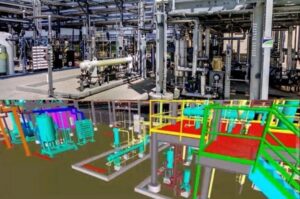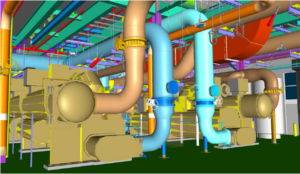Digital Twin Shakedown
By Landmark Venture
Digital twins. The term is beaten to death in the industrial tech space. And I’m tired of it.
So tired of it, in fact, that I decided to write this article, because… have we ever thought about what a digital twin really is?
Sure, we know they’re created to model and optimize the use of objects or processes in real time for any complex system. But are most of us able to draw a line around the term and define it on our own, avoiding the all-too-frequent confusion of digital twins with other representations of physical objects or processes like CAD, finite element analysis, or even static models?
A standard definition is critical here, especially given the rapid growth of the market for digital twins. Consider how IBM (for what IBM’s view on the topic is worth) points out that the valuation of this market could reach up to $48.2 billion by 2026, climbing from a mere $3.1 billion in 2020. McKinsey even highlights that the use of digital twins in Europe alone is expected to increase by up to 45% between now and 2025.
So understanding exactly, precisely, explicitly what a digital twin is, in a world where it seems every other marketing email or sales call you get is about them, can help you sift through the half-truths and understand, once and for all, what a digital twin can really do for your operations.
Not Just Any Digital Model…
First off, the term digital twin is not just another substitute for “simulation” or “model.” Why?
Dick Slansky, 22-year veteran at ARC Advisory Group, a leading research and advisory firm operating in the industrial tech space for nearly four decades, expands on this incredibly important difference in an article in Automation World. Slansky points out that a digital twin, while first built using a simulation, requires “real-time data and two-way flow of data between the digital twin models and the sensors and intelligent end devices that collect the data from the asset(s).”
So to be called a digital twin, a digital twin must rely on data produced about the condition and operation of a physical asset or process in real time. Otherwise it’s just another static model.
This means that, though implied by the folks at Accenture, Tata, and Etteplan, it’s impossible to use a digital twin in product development before any tangible, dynamic, and operating asset is even made.
Getting Precise: The Clear Definition We Needed
So, now that we’ve established what a digital twin is not, what exactly should a sound, specific definition of a digital twin contain?
A digital twin is a model that must be made dynamic by taking in data from an actual, real-world physical object or system in operation, whether that be via sensors or edge devices measuring temperature, energy output, or any other parameter. What’s more, any usable digital twin must take in and standardize this environmental data into an understandable, palatable format.
And there it is: together we’ve arrived at a single, standard definition for a digital twin:
“A digital twin is a digital display of a physical object, system, or process operating in real time, created with a static model and altered by real-time condition-related data on the operation of that physical object, system, or process, standardized and portrayed in a consumable, visual format.”
Oil Wells, Glycol, and Cars: Examples of Pure Digital Twins
Now here are some real examples of actual digital twins deployed in the field, with all the features mentioned in our definition.
First, let’s talk about Shell’s digital twin at its Nyhamna gas processing hub in Norway, built by Swedish software company Kongsberg Digital. In October 2019 the company deployed a digital twin of the entire facility, “continuously updated with integrated information reflecting the status of the facility in real time.” Pretty cool.
Even cooler is the fact that Shell claims it’s saved about $3 million in the form of increases in energy efficiency and process optimization, convincing the company to have another digital twin built out, this time modeling its operations in the Norwegian Sea’s massive Ormen Lange oilfield. Shell’s Ormen Lange digital twin specifically uses real-time distributed control system (DCS) and productivity index (PI) data from subsea pipelines, well surface locations, and wellbore paths. The twin is rapidly improving Shell’s subsea maintenance and engineering operations by establishing a unified, single source of truth observable by multiple departments within the company.
What’s more, take a look at LyondellBasell’s digital twin, modeling in real time a glycol unit at the chemicals giant’s Center for Petrochemical, Energy, and Technology (CPET). The technology informs pre-constructed models with real-world data from inspections and maintenance operations, forging a digital replica of the glycol unit and used for training socially distanced workers.

A comparison of LyondellBasell’s CPET facility and its digital twin
And over in the auto industry, Nissan has already deployed a host of digital twins, combining static models with data collected from the edge at its Sunderland manufacturing facility in the UK. The company twinned a cylinder head machining line, simulating various scenarios with different pallet volumes to optimize the line’s performance, showing Nissan that it only needed 70 pallets to support desired production levels, saving the company over around $26,000 in just one instance.
In addition, Ford has built a digital twin of the Central Energy Plant (CEP) at its Dearborn, Michigan campus. The twin takes in data collected from heat recovery chillers, electric centrifugal chillers, and thermal energy storage, among other assets (via IoT-connected devices), integrating the data with a pre-created three-dimensional model of the entire plant and its systems. The twin enables Ford to optimize the delivery of steam, hot water, and chilled water throughout the plant, mitigating the risk of equipment failure and thereby lowering operating costs.

A 3D model of the pumps system in Ford’s Dearborn Central Energy Plant
The Takeaway
So great, we can define a digital twin. And we looked at some examples. But what’s next? How will digital twins continue to solve increasingly complex problems in these industries?
Given the propagation of artificial intelligence alongside digital twins, rather than having a team of engineers optimizing a modeled asset by viewing its digital twin, the modeled piece of equipment or process could eventually be trained to optimize itself. So rather than a human viewing a digital twin and more intelligently using a modeled asset, a computer could do it orders of magnitude more quickly.
The sky is the limit here: as it should be. The fun in digital twins is their open-endedness, and the future for this space is wide open. And now that you know full well what a digital twin is, and what it isn’t, you’re already a step ahead of most in a market where most don’t know the difference.
Read More About Landmark
in the News.

